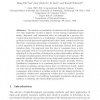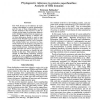1099 search results - page 17 / 220 » On the Complexity of Computing Evolutionary Trees |
DAM
2007
14 years 11 months ago
2007
It is now well-documented that the structure of evolutionary relationships between a set of present-day species is not necessarily tree-like. The reason for this is that reticulat...
EVOW
2007
Springer
15 years 5 months ago
2007
Springer
We present several practical improvements to the interactive evolution of 2D images, some of which are also applicable to more general genetic programming problems. We introduce tr...
139
click to vote
ISBRA
2010
Springer
14 years 10 months ago
2010
Springer
The random accumulation of variations in the human genome over time implicitly encodes a history of how human populations have arisen, dispersed, and intermixed since we emerged as...
ISMB
1998
15 years 1 months ago
1998
This workfocuses on the inference of evolutionary relationships in protein superfamilies, and the uses of these relationships to identify keypositions in the structure, to infer a...
JACM
2006
14 years 11 months ago
2006
Abstract. Maximum likelihood (ML) is an increasingly popular optimality criterion for selecting evolutionary trees [Felsenstein 1981]. Finding optimal ML trees appears to be a very...



